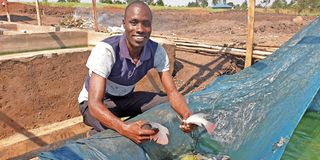Hey, pond fish is just as good as that from the lake

Collins Ojinjo on their fish farm in Awendo, Migori County. Together with his uncle, Leaky Amollo, they currently have nine ponds stocked with fish comprising 7,000 tilapia and 2,000 cat fish. They are working on stocking the rest of their ponds.
What you need to know:
- My interest was in law but my father would hear none of it. He insisted that I join the institution, and take the aquaculture course.
- We had to devise a strategy, we would buy fish from the lake and mix with ours then sell at Awendo market at Sh300 a piece.
- We sell the fish locally to vendors, who resell. There is enough demand locally.
- Each pond should be labelled in terms of date of stocking, capacity, number of fingerings and expected date of harvest.
Collins Ojinjo keeps fish in nine out of 22 ponds he has in Awendo, Migori County. The fish farmer, who holds a degree in fisheries management, started the project in 2017. Rachel Kibui spoke to him and an aquaculture scientist
Why fish farming?
Ojinjo: I can call it fate. My dalliance with tilapia fish farming started when I scored a B+ in KCSE exams and was admitted to South Eastern University of Kenya to pursue a degree in fisheries management and aquaculture technology.
My interest was in law but my father would hear none of it. He insisted that I join the institution, and take the aquaculture course.
Today, I am grateful that I missed law because I have fallen in love with fish farming.
How did you start the project?
Ojinjo: While in second year in late 2017, I talked to my uncle, Leaky Amollo, and shared with him my wish to start a fish farm and he liked my idea.
We agreed to do the business together. We dug the first fish pond, which was 10 by 20 metres, and in early 2018, we bought 1,500 fingerlings from Kisumu Lake Basin Hatchery at Sh5,000.
After six months, we harvested 1,000 fish and sold each at Sh300.
But it was not easy to market the fish since locals prefer the catch from the nearby Lake Victoria.
We had to devise a strategy, we would buy fish from the lake and mix with ours then sell at Awendo market at Sh300 a piece.
You have 22 ponds, how did you attain that feat?
Ojinjo: We have been ploughing most of our income back into the business as we hope to achieve 10 acres of fish ponds in the near future and venture into value addition.Every time we harvest fish, we dig one or two ponds.
Currently, nine ponds have fish stock comprising 7,000 tilapia and 2,000 cat fish. We are working on stocking the rest.
We sell the fish locally to vendors, who resell. There is enough demand locally.
So far, I have employed a manager who works with about 20 casuals in taking care of the ponds.
Do you have any challenges with diseases and pests?
Ojinjo: So far I have not encountered diseases but my biggest challenge is thieves.
They once harvested about 500 tilapias in one night.
What lesson have you learnt from the fish business?
Ojinjo: Kenyans generally don’t like pond fish but they need to know it’s as good as that from the lake.
I know it will take sometime for people to fully embrace farmed fish but the truth is produce from Lake Victoria is dwindling.
Also, as a fish farmer, you need to have a good marketing team that will be able to sell your product by presenting the competitive advantage you have.
How do you take care of the ponds for higher harvest?
Ojinjo: I empty them after each harvest. I then apply lime to kill any organisms before putting water and restocking.
I also monitor the cleanliness of pond water regularly. Besides commercial feeds, I boil cow blood that I source from slaughterhouses and feed to the fish because blood has high protein.
This is a secret I learnt while on attachment at Kenya Marine and Fisheries Research Institute (KMFRI)
What comprises of a good fish farm
Jane Fonda, research scientist KMFRI: It should have a hatchery which should always be warm; what should be the same case with the main pond.
Oxygen cylinders, packing bags and refrigerators are also needed. Each pond should be labelled in terms of date of stocking, capacity, number of fingerings and expected date of harvest.





